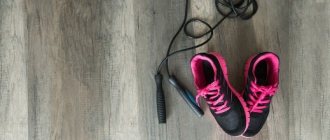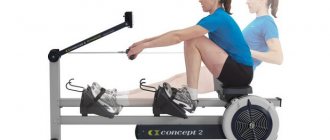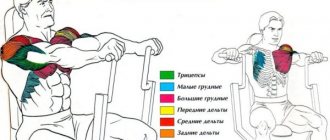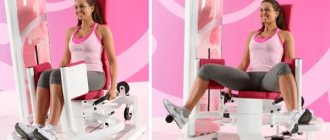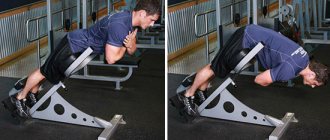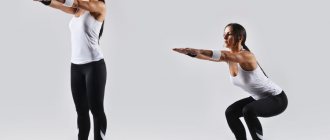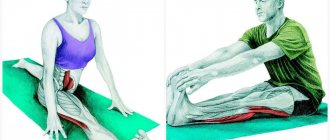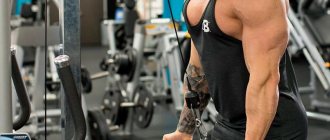Types of Roman chair
There are several types of Roman chair. Here they are:
- Inclined bench with soft bolsters at the bottom. On this apparatus you need to position yourself so that your feet are behind the bolsters. You need to lie down completely on the machine so that your back, shoulders and head fit tightly to the bench.
Inclined bench with soft bolsters for feet and knees. In this case, the upper rollers are placed under the knees, and the feet are placed behind the lower ones. In this case, the back, shoulders and head should fit tightly to the bench.
- Roman chair for hyperextension. In this case, the simulator has soft rollers, behind which the feet should be pulled back. Here, instead of the usual bench, there is a seat. Therefore, you do not need to lie down on the simulator, but sit down.
Whatever type of exercise machine you choose, the principle will be the same - lifting the torso or legs to pump up muscles.
What exercises can you do on a Roman chair?
The Roman chair is a machine on which you can do exercises such as twisting and hyperextension.
Roman chair at home
As already mentioned, exercises on the Roman chair can be performed at home. To do this, you will need to purchase this simulator. This can be either a bench for crunches or a machine for performing exercises such as hyperextensions. The technique will be the same as when training in the gym.
At home, exercises can be performed daily. However, you need to remember about safety precautions. No one can back you up at home. Therefore, experts recommend training on a Roman chair only in the gym.
Exercises on a Roman chair help to quickly and effectively pump up your abdominal and back muscles. Training can be done both in the gym and at home. The main thing is to try not to miss classes, do everything correctly and remember safety precautions.
Roman chair crunches
You can do abdominal crunches on a Roman chair. This exercise pumps up almost all the abdominal muscles. Only with the help of it alone can you achieve the appearance of a beautiful relief on the press. The key to success in this case is to do body lifts correctly and regularly. The technique for performing twists is as follows:
You can pump up your abs on a Roman chair in other ways. There is a type of exercise called oblique crunches. In this case, lifting the body should not be done straight, but with a deviation to the side. In this case, one hand should be placed behind the head, and the other should rest on the thigh. When lifting the body, you need to touch the opposite leg with the elbow of the hand that is located behind the head.
There are also reverse crunches. In this case, you need to perform not lifting the torso, but lifting the legs and pelvis. In this case, the head should be located on the Roman chair where the legs should have been. In this case, you should grasp the soft rollers with your hands. As you exhale, you need to raise your legs and pelvis. When you inhale, you should return them back.
Recommendations for implementation
As with any exercise, there are points that you should pay special attention to when performing hyperextension.
Here they are:
- Posture. The lower back is always and in any position arched so that the pelvis goes back, and should not be round.
- If you want to pump the muscles that straighten the spine (run along it) along its entire length, bend your back as much as possible (lower your body as low as possible). At the same time, the lower back also bends, but back. This option loads the spine and is not recommended as a working option. Many coaches correct students when they see such performance.
- If you leave your pelvis hanging in the air (the pad of the machine rests on the middle of your thigh), the load will go more from your back to your buttocks and the back of your legs.
- We go down as we inhale, we rise as we exhale. And at the top point we linger for 1–2 seconds.
- Remember how to do hyperextensions correctly before lifting weights.
Hyperextension on a Roman chair
Hyperextension is an exercise that is performed on a Roman chair. Their main goal is to pump up the muscles of the back, abs and buttocks.
You need to do these exercises as follows:
- Take the starting position on the simulator: sit on the seat, move your feet behind the lower rollers. Cross your arms over your chest.
- Inhale and tilt your body back, rounding your back. In this case, the torso should lower by 60 degrees.
- Inhale and come back. Perform 20-25 repetitions and 3 sets.
Hyperextension has rules for execution. First of all, you should not allow your body to tilt too low. If you hold your back at an angle of 90 degrees, the spine will receive a strong load and problems may eventually arise.
In addition, you need to control the deflection itself. So, if you keep your back straight, then again there will be too much stress on the spine. You also need to watch your feet. You can't bend your knees. The legs should only be straight, otherwise the exercise will be performed incorrectly.
Hyperextension can be performed in another way. In this case, you should be placed face down on the simulator. In this case, the seat should be located under the hips, and the feet and legs should be placed behind the soft bolsters. Next, also follow the downward bends, rounding the back. It is not recommended to tilt the body too low. 60 degrees of inclination will be enough.
Such exercises are not recommended for people with back problems, otherwise they can worsen the situation.
Execution technique
Before we look at sit-ups and crunches on a Roman chair or bench, let’s look at several options for exercise machines that are found in gyms. This will allow you not to get confused when you see a “dissimilar” unit in your fitness club.
So, what is called an abdominal bench or Roman chair can be the following:
- An inclined bench with bolsters for supporting the legs and knees. The athlete lies on the bench with his back, bends his hips and knees. This position is reminiscent of the position when swinging the press on the floor (back straight, legs bent at the knees), only you are not lying horizontally, but upside down. This version of the simulator is considered optimal, since with this position of the hips (they are bent), the lower back is activated minimally.
- An incline bench with bolsters only to support the lower legs. The athlete lies on such a bench with his back, bends his knees and places his ankle joints behind the bolsters. The hips and back form one line. In this case, the load on the lower back is greater than in the previous one.
- A regular hyperextension machine, only the athlete turns 180 degrees in it, sitting on the pads with his hips. With this exercise, the backward movement of the body is not limited in any way, and, say, a beginner is not always able to control the work of the muscles and strictly follow the technique. Not a recommended option due to its increased risk of injury.
Regardless of which machine you perform the exercise on, the movement technique should be as follows:
- Take your starting position on the bench. Your legs should be locked and your abdominal muscles tense. Abdominal relaxation does not occur throughout the entire exercise. The lower back should be as straight as possible, that is, actually pressed against the bench in the starting position. Further, if you do crunches, the lower back remains as pressed as possible. If you perform lifts, the lower back lifts off the bench, but there is no deflection in the lumbar region. When performing the exercise on a machine with two rollers (for the shins and knees), it is quite easy to follow this rule, since the hips are bent. In the case of a bench with support only for the legs, keeping the lower back close to the bench will interfere with the buttocks. Therefore, when performing the exercise, you do not lower your back completely onto the bench. That is, the spine is always slightly rounded. If you pump your abs on a hyperextension machine, there is no support for your lower back at all; the position of your body is controlled solely by the strength of your muscles.
- You can cross your arms over your chest or put them behind your head (it’s harder to do this).
- As you exhale, lift your body. When performing crunches, only the shoulder blades come off the bench. When doing lifts, raise your entire body 30-60 degrees above parallel with the floor. Simply put, about half as low as before the vertical position of the body.
- Slowly and under control, without relaxing your abs or arching your back, return to the starting position.
Perform the exercise 20–30 times in 3–4 approaches. The last repetitions should be as hard as possible for you. However, do not allow your muscles to become so tired that you break your technique.
When performing body lifts, avoid jerking. A slow pace, on the one hand, will make abdominal training more effective, and on the other hand, it will help you better control the movements, making the exercise safe for your back. For twists this is not so important.
A few months of regular abdominal workouts will help you make your stomach firm and your sides toned. It is also worth saying that in order to see the drawn relief (the treasured cubes and lines on the sides of the abdomen), the thickness of the fat layer on the abdomen should be minimal.
Roman chair - features and types of simulator, exercise technique
The Roman chair is a strength machine with which you can perform a number of exercises to work out and develop the lower and middle parts of the body with weights in the form of your own weight. The Roman chair exercise machine is a structure made of steel pipes, reminiscent of a bench with bolsters for the legs. Exercise machines of this type have an adjustable backrest angle and allow athletes of any level of training and height to work on them. The machine can also be used to develop the gluteal muscles and hamstrings.
Types of Roman chair exercise equipment
There are several types of Roman chair exercise equipment. They can be divided into two types:
There are also hyperextension machines that have a fixed angle design. These simulators differ in the ability to perform hyperextension and crunches. For example, on a simulator that has a horizontal position, you can perform two versions of the exercise for the lumbar and abdominal regions at once. Machines with a downward angle do not allow hyperextension, and a hyperextension machine with an upward angle does not allow the abdominal muscles to be trained.
1. Roman chair for inclined abs 2. Roman chair horizontal for sit-ups and crunches 3. Roman chair for abs 4. Roman chair for hyperextensions
Crunches and sit-ups on an incline bench or Roman chair
The material was prepared by the site team with the support of our experts: athletes, coaches and nutrition specialists. Our team >>
- Reading time: 4 min.
- Crunches or sit-ups?
- The benefits of abdominal exercises
- Execution technique
Today we will look at two very similar and very effective abdominal exercises - sit-ups and crunches on an incline bench or Roman chair. There are a lot of variations of these exercise machines, but our task will be to analyze the features and technique of the movement itself, so that being in any gym with any equipment, you can train your abdominal muscles one hundred percent!
How to do Roman chair crunches
- Fixing your shins between the rollers, tensing your abdominal muscles, bend your torso and pull your torso towards your knees.
- The exercise is performed while exhaling.
- At the peak of the movement, you should linger for a while, after which you need to return to the starting position.
- The reverse movement should be done slowly.
- It is very important to shorten the pause in the lying position.
- The inclination of the bench should be 15-30 degrees.
- The athlete's hands can be either at the chest or behind the head.
- The tailbone should be pressed against the bench.
- The neck should be in a neutral position. It does not need to be bent in the direction of body movement (pull forward).
- The movement is performed solely by contracting the abdominal muscles. The chest should be straightened.
- During the return movement you need to inhale.
Athletes with a higher level of physical fitness can perform weight training exercises. When performing crunches, do not use inertial force. Try to perform movements smoothly and concentrated.
Hanging Knee Raise
Goal: working out the rectus abdominis muscles with increased impact on the lower muscles.
Technique:
- Hang on the bar as if you were going to do pull-ups.
- As you inhale, fold your legs together, bend them at the knees, and then pull this structure to the bottom of your chest.
- As you exhale, bring your legs to the starting position.
Exercise for beginners. Anyone who has done a serious abdominal workout at least once knows that the next day you feel like a weak-willed vegetable who cannot bend, straighten, or simply walk without pain in the abdominal area. In order not to discourage you from training, we recommend starting your abdominal workout with hanging knee raises.
This and the next exercise can be performed hanging on a bar, on a wall bars, on uneven bars, or on a machine that combines a horizontal bar with parallel bars and a backrest with armrests.
How to do a sit-up in a Roman chair
To perform hyperextension, horizontal type exercise machines and a Roman chair for hyperextension, which has an upward slope, are suitable.
- To perform the exercise, you need to take a position in the machine face down.
- The heels need to be rested under the bolsters.
- Keeping your abdominal muscles tense, lower your body down while inhaling, exhale on the reverse movement and return to the starting position using the muscles of the lumbar region.
- In the starting position, the body should form a straight line. At the top you need to take a short pause. There should be no bend in the lower back.
In this exercise, just like with crunches, you do not need to use the force of inertia. To increase results in the future, you can perform the exercise using weights, dumbbells, weights and discs.
Crunches or sit-ups?
First of all, it’s worth understanding how crunches on a bench differ from sit-ups. When twisting, only your shoulder blades come off the bench; there is no movement in the hip joint. The lower back remains motionless.
When lifting the body, not only flexion of the spine occurs, but also movement in the hip joint.
Twisting is recommended for beginners, as the load on the lower back when performing them is minimal. However, the load on the abdominal muscles during crunches is also less than in the case of sit-ups. Lift-ups require better control of the lower back and are recommended for people with developed abdominal muscles.
What exactly you should do, crunches or sit-ups, depends on your physical fitness. There is only one condition - you should feel your abs, not your back.
How to choose a Roman chair for abs and hyperextension for home
- Pay attention to the possibility of changing the angle of the bench. Thanks to this, the simulator becomes accessible to people of any level of training. This nuance is very important for a home exercise machine.
- High-strength structures have radial bends and roundings on the frame.
- Advantage should be given to those simulators made entirely of metal, which have the least amount of plastic parts.
- The materials with which the frame is sheathed should not be slippery. An excellent option would be leather-covered seats. The strongest threads used to sew leather are reinforced threads.
- The bolsters for fixing the legs should be soft.
- It is also important to pay attention to the labeling of the simulator, which contains information about the maximum allowable weight of the user.
What is a Roman chair exercise machine and how to exercise on it correctly
Since the times of the gladiators, there has been no more effective exercise machine for strengthening the back and abdominal muscles than the Roman chair. This is a classic simulator, presented by manufacturers in several variations. It can be found in any gym and more than half of beginners choose it to start training; it is especially popular among women.
What does it look like?
Despite the large number of modifications of the simulator, each has the following basic elements:
- a frame that ensures stability of the structure at rest and during exercise;
- seat with small dimensions;
- emphasis in the form of rollers. They should be upholstered with soft material, there may be several stops.
Modern models allow you to change the height of the seat and rest, and change the angle of the bench to suit different heights. There may be compact folding models for the home and larger and stronger ones for the gym.
What exercises is it intended for?
Hyperextension on a Roman chair
The main purpose of the Roman chair is hyperextension, that is, stretching and straightening the muscles of the back, abdominals, and buttocks. It can be used to perform crunches for a specific muscle group. It is not suitable for pumping up muscles, but is used before weight training and squats to warm up the body. You can exercise on a Roman chair after your main workout to stretch stressed muscles.
Exercise technique
Scheme of muscle activation when performing hyperextension
Effective exercise is possible only if each exercise is performed correctly; mistakes lead to injuries and wasted effort. The rules for using the simulator are as follows:
- Adjustment. Before class, you need to move the front rollers to the level of the bend of the lower back and hips. The lower rollers are lowered to the Achilles tendon, leaving them slightly higher.
- Starting position. If the exercise is performed while sitting, then the buttocks should be positioned clearly on the seat, without protruding beyond it. The shins rest on the bolsters. Another option for performing the exercises is to place your feet under the lower bolster, with your upper thighs resting on the seat. Legs and back should be on the same line.
- Inhale, tighten your gluteal muscles, and as you exhale, lower your torso below hip level. The tilt angle should be approximately 60°. Round your back a little. Exhale and cross your arms over your chest.
- As you inhale, a smooth rise of the body to the initial level begins. Lock yourself in position. Do it all again.
Ab exercise
The main subtleties of performing the exercises: fixation at the lowest point and in the starting position, as well as lowering is accompanied by exhalation, and lifting by inhaling. All movements must be performed at a slow or moderately slow pace.
Beginners can simplify the task a little by reducing the amplitude of the tilt. In this case, the main load will fall on the muscles of the buttocks and thighs.
If the activity seems very simple, then you can complicate it by pulling one leg out of the brace. It is worth repeating the exercise with one and the other leg to ensure an even load on all muscles.
There are several variations of the exercise. The housing can be positioned at an angle to the floor or parallel. You can lie on your side to exercise your oblique muscles. To train the buttocks and hamstrings, the emphasis is on the middle of the thigh. Reverse hyperextension involves strengthening the torso, not the legs. This exercise is recommended for those who have back problems.
If everything is done correctly, the main load will be in the lumbar region. This is easy to check. When you get up after class, this area will be very warm and there will be a rush of blood. It will also feel like you swallowed a stake.
Scheme of muscle activation when performing abdominal exercises
Mistakes to Avoid
Despite the apparent simplicity of all possible exercises, very often people make mistakes:
- The amplitude is too large, up to 90°. This depth of inclination can be afforded by people with a strong back, without scoliosis or other curvatures.
- Strong deflection. A common mistake is when a person bends too far back when lifting the body. This breaks the straight line and redistributes the load incorrectly. Lifting with a completely straight back is also incorrect.
- Full amplitude. The trainee combines both previous mistakes in one exercise and begins to swing his body too much.
- Leg bending. Sometimes the body tries to make the task easier for itself, and the legs bend at the knee joint. With proper training on the Roman chair, the whole body should be taut like a string.
- Incorrect hand position. When practicing, you can place your arms on your chest, bending your elbows, or put them behind your head. In the second case, the angle between them is 180°, and they lightly touch the back of the head; there is no need to lock them tightly together or press them tightly against the head.
- Too much weight. To increase the load, you can additionally use weights. Many people rush to increase the load from the first lesson and “break their backs.” Beginners should definitely train empty the first time.
Home hyperextensions
At home, this exercise can be used to improve your back health and stabilize your spine.
Fitball
A fitness ball is an excellent option for working out your abs and lower back at home. This is also a good option for pregnant women or people experiencing lower back pain.
The fact is that the spine does not receive the same pressure from gravity as when exercising in a simulator. Because your body is on the shock-absorbing ball.
Let's look at how to do hyperextension on a fitball correctly:
- We put the ball in the middle of the room, lie on it with our backs up so that our feet are on the floor, our pelvis is on the ball, and our torso is in front of the ball.
- We recommend keeping your arms straight in front of you in case you roll down. This will be insurance. The leg muscles hold the legs to the floor (we rest our heels on it).
- We begin to lower our torso down until the ball allows us to do this. So you can lean 45-60 degrees.
- Don't forget about posture - arch in the lower back, shoulders straightened.
- We do the required number of times – usually 15–20 in two approaches. We stretch the muscles after the exercise.
Doing hyperextension in the yard
Notice if there are two parallel pipes (each pipe horizontal) of different heights in the school yard, or on the nearest playground. If there is, we go there to train our back muscles.
- We place our heels under the lower pipe, and with our legs or hips we lie upside down on the higher pipe.
- We recommend placing a towel under the top tube to avoid bruising your legs.
This option is inconvenient because the distance between the pipes cannot be changed, and very often the pipes rest directly on the thighs. Girls may develop bruises from such a point load. And the weather doesn’t always allow you to go out into the yard.
Of course, this is not a special exercise machine or even a Roman chair, but sometimes it helps.
Performing on the couch
Everything is simple here - lie down on the sofa so that your hips and legs are on it. We lie face down. Your partner (or partner) sits on your knees, moving his hands back and resting them on your heels. This way, your knees and heels are fixed to the sofa. And you can do bends with your hands in a comfortable position. Good and useful entertainment.
One disadvantage is that your partner may not be heavy enough, and you will outweigh him. So be prepared to put your hands in front of you. With this version of the exercise, the same muscles work as on a chair or in a machine.
In the gym on a simulator - this is the most effective option.
48.48%
I prefer a fitball - a softer and safer load.
15.15%
I make different options depending on where I am.
15.15%
Other back exercises suit me better.
9.09%
I'm doing hyper... what? ????
12.12%
Voted: 33
Main muscle groups trained on the Roman chair
Lateral raises on a Roman chair
For training, it is important to know which muscle groups are included in the work.
The Roman chair allows you to give load to:
- biceps muscle or biceps femoris;
- semimembranosus femoris muscle;
- semitendinosus femoris muscle;
- calf muscle;
- gluteus maximus muscle;
- abdominal muscles;
- back muscles in the lumbar region.
Diagram of muscle recruitment when performing lateral raises
Buying a simulator
Due to its small dimensions and ease of operation, the exercise machine can be purchased for home use. A reliable, high-quality exercise machine will make training safe, effective and comfortable.
How to choose the right trainer?
Among the large range of products, you need to be able to find a really high-quality model.
When choosing a Roman bench, pay attention to several details:
- Frame. For its manufacture, high-strength steel should be used that will last for more than one year. Chinese models are often made from silumin alloys with a significantly shorter service life.
- Seat and back upholstery. An excellent material would be high quality synthetic non-slip leather. It should not fade or tear over time. The seams must be neat. It is desirable that the material be hypoallergenic, since the area of its contact with the body during exercise is quite large.
- Foot rest. The rollers must also have a durable coating. The inner padding is soft enough to prevent bruising after exercise. The emphasis should be comfortable.
- Frame adjustment. It is desirable to be able to change the angle of the frame and the height of the roller fixation. All regulatory mechanisms should be simple and convenient. The ability to change the height will allow people of different heights to exercise on the machine.
- Maximum load weight. The weight stated in the equipment passport must be comparable to the weight of the person exercising.
Price
The simplest models can be found starting at $160, while the most advanced can cost $2,000. On average, the price of a Roman chair ranges from 11,000 to 35,000 rubles in various stores. Exercise machines in this category differ in their manufacturers and additional features (additional supports).
Popular manufacturers
There are many companies producing sporting goods.
In our market you can find Roman chairs from:
- Body Solid is an American brand that supplies products for home use and professional use;
- Oxygen is a Taiwanese company specializing in inexpensive but high-quality equipment;
- Kettler – German quality exercise equipment;
- Bronze Gym is a German manufacturer with factories in China and Thailand, specializing in budget and mid-range products;
- Matrix - from the manufacturer Johnson Health Tech Co., offering the best equipment for training. Made in USA-Taiwan.
You can also find other less famous brands. The main thing is the quality of the product, not the brand.
Advantages and disadvantages
Regular exercise will help:
- Strengthen the spine. This is an important part of the body on which the well-being of the whole body depends. Strengthening the muscles of the spine will improve lymph flow, blood circulation, and conduction of nerve endings.
- Formation of beautiful posture. This will help improve your perception of yourself and others, add confidence and attractiveness. Good posture means training many muscles, including the glutes and pectorals. The Roman machine simultaneously loads everything at once.
- Preparing the musculoskeletal system for heavy loads and preventing injuries.
The simulator has practically no disadvantages. They can be called:
- Increased load on the lumbar region, which can lead to injury if not approached correctly.
- More suitable for warming up and preparing the body than for high-quality training of certain muscle groups.
The Roman bench is the simplest design of a machine that allows you to make simple abdominal exercises more effective and correct. Before you start, you need to learn the basic mistakes and technique of doing the exercises. This will make the activity more useful and protect you from injury. You need to take care of your body, the Roman chair is well suited for this.
Different training schemes
How to use this exercise depends on your goals.
As a warm-up before a more difficult exercise
We recommend doing 2 warm-up approaches without weight, 15 times each. Can be done immediately after cardio exercise. Then you can start, for example, deadlifting.
If your back hurts
The best option for you is hyperextension on a fitball. Do 2-3 sets of 15 reps. Moreover, the first workout should include only 2 approaches. You can train 2-3 times a week. The benefits are guaranteed.

